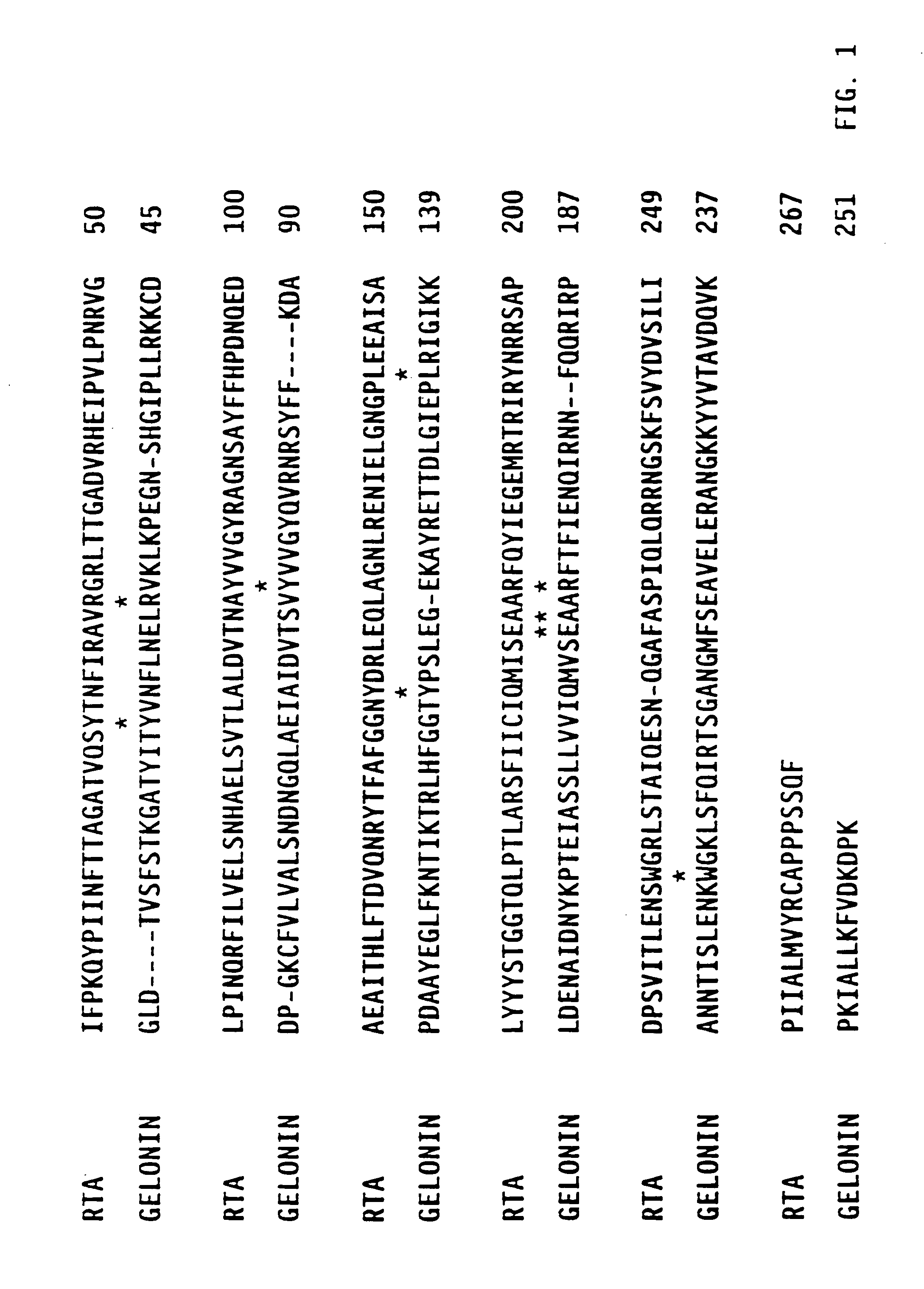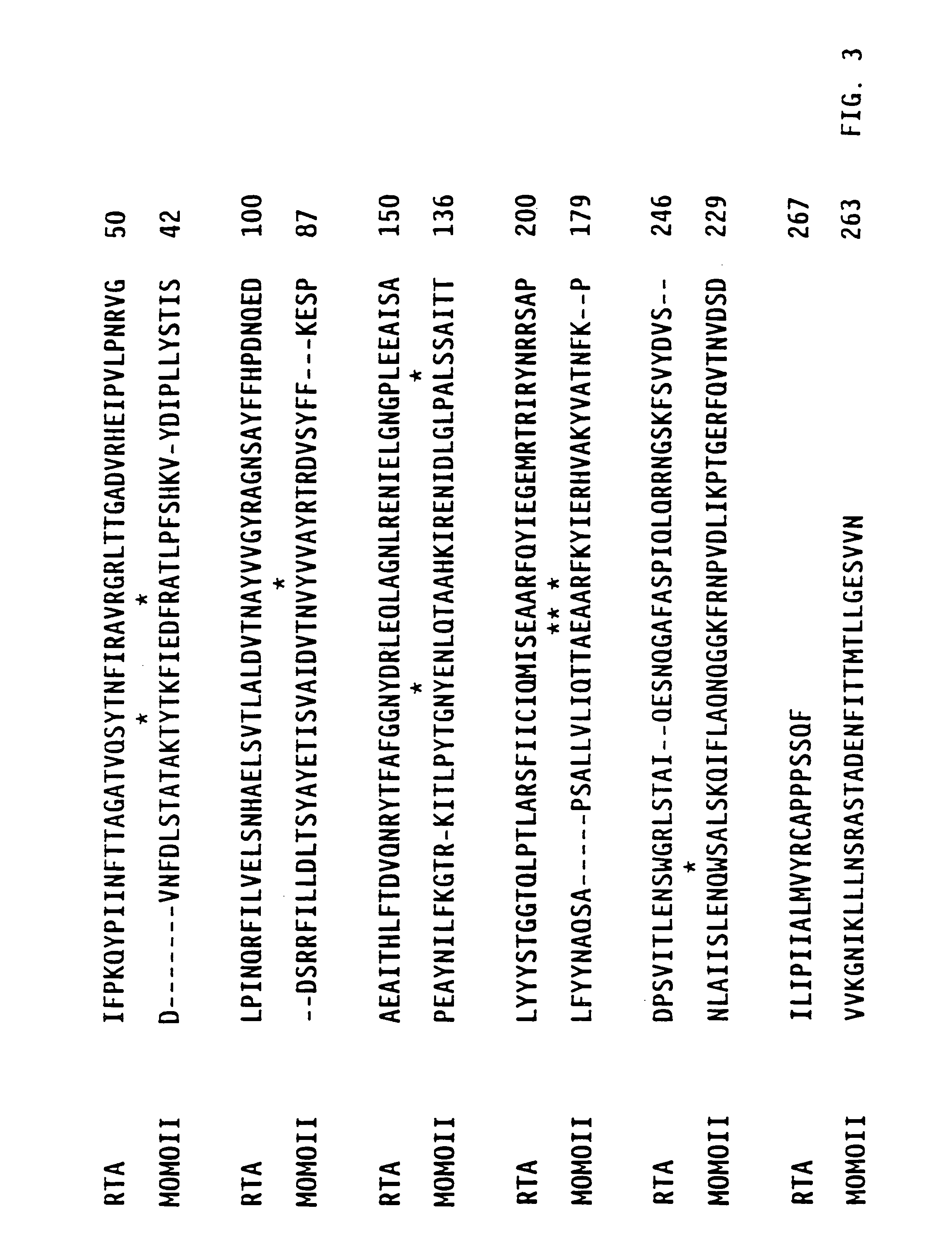Immunotoxins comprising ribosome-inactivating proteins
a technology of ribosomes and proteins, applied in the field of materials, can solve the problems of relatively low intracellular yield, high immunogenicity, toxicity, etc., and achieve the effect of reducing the immunogenic respons
- Summary
- Abstract
- Description
- Claims
- Application Information
AI Technical Summary
Benefits of technology
Problems solved by technology
Method used
Image
Examples
example 1
Preparation of Gelonin
[0101]The cloning of the gelonin gene according to the present invention obviates the requirement of purifying the RIP gene product from its relatively scarce natural source, G. multiflorum seeds. Cloning also allows development of gelonin analogs which may be conjugated to antibodies without prior chemical derivatization and also allows development of gelonin gene fusion products.
A. Preparation of RNA from G. Multiflorum Seeds
[0102]Total RNA was prepared from Gelonium seeds (Dr. Michael Rosenblum, M.D. Anderson Cancer Center, Houston, Tex.) by a modification of the procedure for preparation of plant RNA described in Ausubel et al., eds., Current Protocols in Molecular Biology, Wiley & Sons, 1989. Briefly, 4.0 grams of seeds were ground to a fine powder in a pre-cooled (−70° C.) mortar and pestle with liquid N2. The powder was added to 25 ml Grinding buffer (0.18M Tris, 0.09M LiCl, 4.5 mM EDTA, 1% SDS, pH 8.2) along with 8.5 ml of phenol equilibrated with TLE (...
example 2
A. Construction of Expression Vectors Containing the Gelonin Gene
[0124]A first E. coli expression vector was constructed containing the gelonin gene linked to the Erwinia carotovora pelB leader sequence, and to the Salmonella typhimurium araB promoter. A basic vector containing the araB promoter is described in co-owned U.S. Pat. No. 5,028,530 issued Jul. 2, 1991 which is incorporated by reference herein. The vector containing the araB promoter was cut with EcoRI and XhoI. Two DNA fragments were then ligated in tandem immediately downstream of the promoter. The fragment ligated adjacent to the promoter was a 131 bp fragment derived from SstI digestion, T4 polymerase treatment and digestion with EcoRI of the pIC100 vector which includes the leader sequence of the E. carotovora pelB gene. The translated leader sequence is a signal for secretion of the respective protein through the cytoplasmic membrane. The fragment ligated downstream of the leader sequence was a SmaI to XhoI fragment...
example 3
Assembly of Gelonin Genes with Cysteine Residues Available for Conjugation
[0134]The wild-type gelonin protein has two cysteine residues at positions 44 and 50 which are linked by an endogenous disulfide bond. The protein contains no free cysteine residue directly available for conjugation to antibodies or other proteins. Analogs of gelonin which contain a free cysteine residue available for conjugation were generated by three different approaches. In one approach, various residues along the primary sequence of the gelonin were replaced with a cysteine residue, creating a series of analogs which contain an odd number of cysteine residues. In another approach, one of the two endogenous cysteines was replaced by alanine, creating a molecule which lacks an intrachain disulfide bond but contains a single, unpaired cysteine. In yet another approach both endogenous cysteines were replaced by alanines and a third non-cysteine residue was replaced by a cysteine, creating an analog with a sin...
PUM
| Property | Measurement | Unit |
|---|---|---|
| Molar density | aaaaa | aaaaa |
| Molar density | aaaaa | aaaaa |
| Molar density | aaaaa | aaaaa |
Abstract
Description
Claims
Application Information
 Login to View More
Login to View More - R&D
- Intellectual Property
- Life Sciences
- Materials
- Tech Scout
- Unparalleled Data Quality
- Higher Quality Content
- 60% Fewer Hallucinations
Browse by: Latest US Patents, China's latest patents, Technical Efficacy Thesaurus, Application Domain, Technology Topic, Popular Technical Reports.
© 2025 PatSnap. All rights reserved.Legal|Privacy policy|Modern Slavery Act Transparency Statement|Sitemap|About US| Contact US: help@patsnap.com



